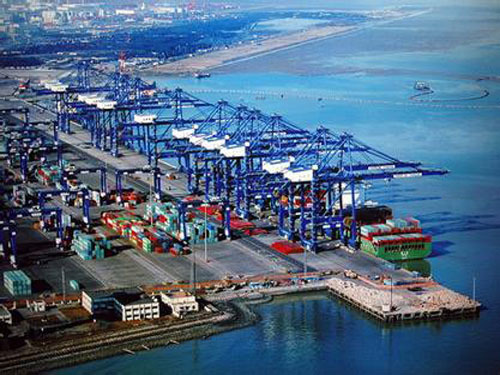
The China Securities Journal quoted Bloomberg reports that Port Ted Marines in Port Hedland in Australia, including deck sailors, are threatening strikers and require employers to increase wages and improve working conditions. Otherwise, they will stop operations and damage the world’s largest iron. Shipments of ore ports. Australia is the main source of iron ore imported from China. Australian ports strike or trigger iron ore price reaction.
Located on the northwest coast of Australia, Port Hedland is the largest exporter of iron ore in Australia and the world. The Australian government expects that the port will undertake the task of exporting nearly half of Australia's cargo ships. It is expected that the total export volume of the port will reach A$76.5 billion by June next year.
At present, the Australian Handicraft Aquatic Association of Port Hedland has approved an unlimited number of stoppages lasting from 2 hours to 12 hours. Australian mining company BHP Billiton data shows that the deck sailor's annual income is approximately 137,000 Australian dollars, if combined with bonuses and subsidies, total income can reach 211 thousand Australian dollars.
BHP Billiton stated that if any strike lasts two days, mining activities may slow down. BHP Billiton expects that the total daily loss of Australian iron ore miners may reach as high as A$100 million on strike.
Michael McCarthy, chief strategy officer of CMC Markets in Sydney, believes that the strikes are not all negative consequences. Any supply crunch will trigger the reaction of iron ore prices, which may offset any short-term income losses. The risk of slowing demand in the Chinese market has increased. Last week, international iron ore prices fell to the lowest level in the past two months.
Global iron ore supply exceeds demand in the Chinese market. Ore prices will remain low during the year.
The First Financial Daily reported that the price of iron ore has fallen more than 25% since the beginning of the year. Due to the declining global economic growth, the demand for iron ore is also falling sharply, and the global supply of iron ore is still not in a state of oversupply. In the Chinese market, ore prices will remain low during the year.
According to reports, Australia is the main source of imported iron ore in China. According to the latest data from the Ministry of Industry and Information Technology, from January to June this year, China's cumulative import of 45.76 million tons of iron ore, an increase of 19.1%, iron ore imports hit a record high. In terms of countries and regions, Australia and Brazil are still the major sources of iron ore imports from China, accounting for 56.1% and 17.6% respectively.
The Ministry of Industry and Information Technology reported earlier that the main reasons for the significant increase in imports of iron ore are as follows: First, the output and shipments of foreign iron ore giants continued to climb; second, the return of some overseas iron ore mines increased.
The Ministry of Industry and Information Technology quoted the statistics released by foreign mining companies and stated that from January to June 2014, Brazil’s Vale, Australia’s Rio Tinto, BHP Billiton, and FMG’s iron ore output both increased by more than 10% year-on-year. Among them, FMG's iron ore production in the second quarter was 43.8 million tons, up 28% year-on-year, and the shipment volume was 37.6 million tons, a year-on-year increase of 58%, both reaching a record level.
The oversupply of the global iron ore market still does not ease the Goldman Sachs Group's analysis that the current low iron ore prices in the Chinese market are sufficiently competitive and will suppress high-cost marginal supply. Iron ore prices may remain volatile in the range for the rest of this year, unless China relaxes its policy or has problems with supply, and the price upside risks are limited. In the longer term, the iron ore market is still in the initial stage of oversupply. In 2015, the supply of imported iron ore will increase again, and the growth of China's steel output will further slow down.
In addition to foreign mines, the output of the four major mines in the country increased by more than 10% in the first half of this year. The CCB Futures report pointed out that from historical statistics in recent years, the amount of imported ore in the second half of the year tends to exceed that of the first half of the year. With the decline in ore prices, the competition between mines has become increasingly fierce. From the current attitude of mines, the original expansion plan will continue to accelerate, so in the second half of the year that can be expected, the mine's increment and shipments It will remain high.
In the absence of a significant decline in port inventory, supply pressure is expected to continue to suppress the formation of iron ore. Port stocks are still high, and supply pressures have not diminished. The risk of financing mines has not yet significantly eased and market selling pressure remains.
According to the analysis of Ruida Futures, the recent transactions in the imported ore market are active, but resources are mainly concentrated in the hands of traders and do not flow into end users. On the contrary, the steel mills currently serving as end-users are mostly cautiously purchasing and purchasing on demand.
According to report, as of August 8th week, the port iron ore inventory still exceeded 100 million tons. This high inventory situation has continued for several months.
Although the risk exposure of iron ore financing had previously led banks to step up their control over iron ore trade finance, stocks remained at levels above 100 million tons since mid-March, and supply remained relaxed.
On the one hand, high inventory levels, on the one hand, prices fell sharply. According to Baocheng Futures data, as of August 15, the average spot price of imported ores for spot trading was 682.76 yuan per ton, a decrease of 39% from the beginning of the year; the average price of domestic iron ore was 727.06 yuan per ton, which was a decrease from the beginning of the year. 25.9%.
The Ministry of Industry and Information Technology also expects that in the second half of this year, under the new normal economic development, domestic crude steel production will continue to maintain low-speed growth, ore prices will linger at low levels, and the iron ore market will still exhibit a pattern of oversupply.
Goldman Sachs predicts that the target price for iron ore in 2015 will be US$80 per ton. Goldman Sachs believes that the structural driving factors for bearish iron ore include: Supply growth exceeds demand growth by a ratio of 3-1, and labor productivity in the iron ore industry has pushed down unit production costs.
Our Sandwich Bag offers packing for any kitchen staff, whether it is the parents making their kid's lunch or a restaurant keeping the food fresh. Great for fast food operations or for prepackaged deli cases. Tear-resistance and preventing spills so keep hands and clothes staying clean. The Bag is made of virgin Low-Density Polyethylene (LDPE) resin or High-Density Polyethylene (HDPE) resin, which meets BRC and FDA requirements for food contact.

Plastic Sandwich Bag, Sandwich Baggies, Reusable Sandwich Bags,Reusable Ziplock Bags,Paper Sandwich Bags,Plastic Sandwich Bags
BILLION PLASTIC MANUFACTURING CO.,LTD, JIANGMEN , https://www.jmtshirtbag.com